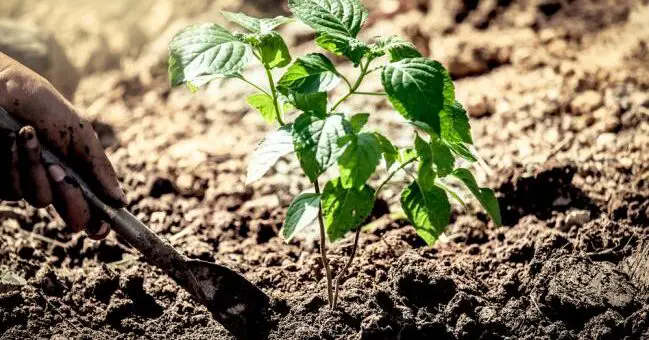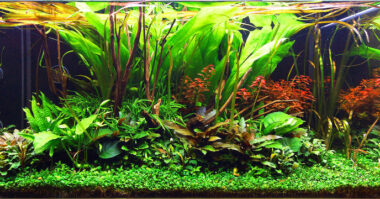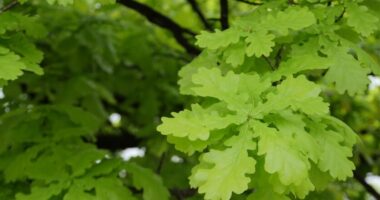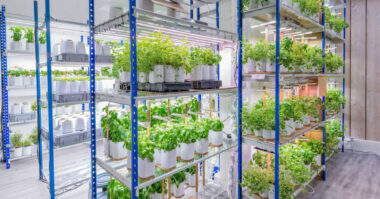To grow, plants need water, light, carbon, oxygen and mineral elements. Air provides oxygen and carbon dioxide, the source of carbon, which the plant fixes through photosynthesis.
The soil serves as a reserve of water and mineral elements to feed the plant, it is a real bio-reactor that houses a complex ecosystem. The soil recycles organic matter into mineral elements that can be used again by the plants and provide the farmer with a good yield!
So they don’t need any food in terms of external input, like one could feed dogs or cats! However, it is recommended to give indoor plants a boost with fertilizer or substrate.
Contents
The three essential elements that plants need in order to live
The light
Light is essential for the function of photosynthesis, through which plant species obtain the elements they need to grow and develop. During this process, they also absorb carbon dioxide particles that are harmful to our health and release the oxygen that enters our lungs.
Some species can live in interior spaces with little light. However, most of them gradually lose their color and may even perish if they do not receive the amount of light they need.
Oxygen and carbon
Without these two elements, which they obtain through water and air, plants would simply cease to exist.
Water
Plants get the hydrogen they need from water, which they absorb through their roots and where all the minerals they need are found. At first glance you can recognize a dehydrated plant because its leaves curl up, lose their color, its flowers dry out and its fruits shrivel up.
Feeding the soil to nourish the plants
The natural process of fertilization
In nature, it is their environment that feeds the plants, they do not need any input to be healthy and vigorous. They use the carbon dioxide present in the air through the process of photosynthesis and absorb the rest (water and mineral salts) in the soil through their root system.
The soil is self-sustaining thanks to the various organic matter (woody debris, leaves, dry grass, insects and dead animals, …) which decompose and eventually form a fertile and beneficial humus.
The organic and mineral compounds guarantee the storage of water and nutrients in the soil, preventing them from being washed away by rainwater or evaporating. The microfauna transforms the organic matter that is deposited on the surface into new nutrients, elements that will nourish the plants, give them something to defend themselves against aggression, etc.
Why feed the soil?
Without a regular supply of organic matter, the soil is gradually depleted by the effect of mineralization and by the use by plants of the nutrients stored in it. This loss also results in a more compact soil, which easily forms a hard crust on the surface.
In order for the soil to be stable in its composition, it must be amended by adding organic waste as often as possible: mowing waste, dead leaves, mulch, crop residues, …
How to feed the soil?
Natural fertilizers are transformed (i.e. mineralized) by the microorganisms living in the soil (the soil fauna) and the nutrients they contain are thus made available to plants. They therefore complement the input of organic matter or replace it when this could not be achieved.
Their action is progressive, because this transformation is done according to different factors such as temperature or humidity. The cycle of decomposition/absorption is therefore similar to what happens in nature and there is practically no risk of root burns and leaching into the water table as there can be with chemical fertilizers that provide nutrients that are immediately assimilated by plants.
The needs of each type of plant
The needs of flowers
They need mainly nitrogen at the beginning for the development of their aerial parts, stems and leaves, then potassium which favours the flowering process.
To be integrated into the substrate at planting time, the fertilizer for geraniums and other flowering plants Solabiol ensures an abundant and colorful bloom throughout the season thanks to its richness in nitrogen and potassium. It can also be used in maintenance to support this flowering.
The needs of shrubs
Shrubs require a more balanced composition between the different elements, as well as nitrogen for a beautiful green foliage, phosphorus for vigorous roots and the couple phosphorus and potassium for many flowers.
Solabiol Roses and Flowering Shrubs fertilizer offers a well-balanced composition of nitrogen, phosphorus and potassium, elements that are supplied to the plant in a soft and progressive way for a harmonious growth, healthy and bright foliage and a generous flowering.
In 2 contributions in the year the shrubs benefit from all the nutrients which are necessary to them and the soil in which they are installed improves.
The needs of the vegetable garden
Depending on the vegetable plants, the fertilizer to be used will be composed differently:
- More nitrogen for leafy greens, spinach, chard,
- More potassium and phosphorus for fruiting vegetables such as tomatoes, eggplants, cucumbers, courgettes, …
The natural fertilizer for tomatoes and fruit vegetables promotes the development of all fruiting vegetable plants. Thanks to its richness in potash, the fruit, which is earlier, is larger in size and has a much more flavourful taste.
This fertilizer also contains a root stimulator, which allows plants to absorb more nutrients and thus produce more fruit! Only 2 inputs are necessary, the first before planting, the second before the end of the harvest.
Some fertilizers are versatile and are suitable for all vegetable plants due to their well-balanced composition, such as Solabiol’s organic vegetable garden fertilizer. Thanks to its 100% organic components, it nourishes the soil and plants, providing them with the nutrients to quickly develop an extensive root system, grow and fruit generously.
Summary
In simple terms, we can say that plants are composed of water, organic elements and mineral salts. In their natural habitat, they are able to obtain most of the nutrients and elements they need to live.
However, the plants that adorn our homes and workplaces need a little help from us to grow healthy and become beautiful! We explain everything about plant food.








